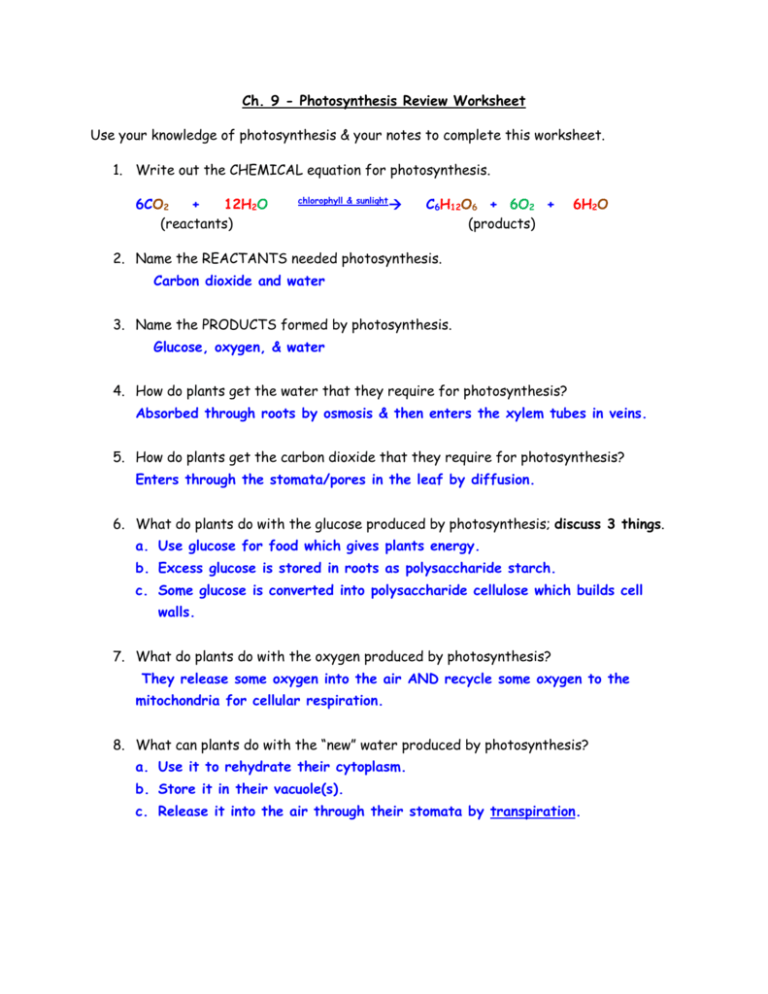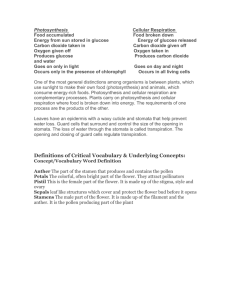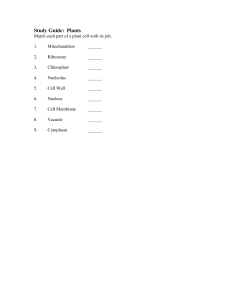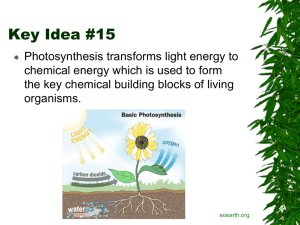Ch. 9 - Photosynthesis Review Worksheet Use your knowledge of
advertisement

Ch. 9 - Photosynthesis Review Worksheet Use your knowledge of photosynthesis & your notes to complete this worksheet. 1. Write out the CHEMICAL equation for photosynthesis. 6CO2 + 12H2O (reactants) chlorophyll & sunlight C6H12O6 + 6O2 + (products) 6H2O 2. Name the REACTANTS needed photosynthesis. Carbon dioxide and water 3. Name the PRODUCTS formed by photosynthesis. Glucose, oxygen, & water 4. How do plants get the water that they require for photosynthesis? Absorbed through roots by osmosis & then enters the xylem tubes in veins. 5. How do plants get the carbon dioxide that they require for photosynthesis? Enters through the stomata/pores in the leaf by diffusion. 6. What do plants do with the glucose produced by photosynthesis; discuss 3 things. a. Use glucose for food which gives plants energy. b. Excess glucose is stored in roots as polysaccharide starch. c. Some glucose is converted into polysaccharide cellulose which builds cell walls. 7. What do plants do with the oxygen produced by photosynthesis? They release some oxygen into the air AND recycle some oxygen to the mitochondria for cellular respiration. 8. What can plants do with the “new” water produced by photosynthesis? a. Use it to rehydrate their cytoplasm. b. Store it in their vacuole(s). c. Release it into the air through their stomata by transpiration. 9. What happens during transpiration? Water vapor is released into the air through the stomata. 10. In what plant ORGANELLE does photosynthesis occur? Chloroplasts 11. Name the green PIGMENT inside the chloroplast. Chlorophyll 12. What is the function of chlorophyll? To absorb energy from sunlight. 13. Where in the chloroplast is the chlorophyll located; thylakoid/grana or stroma? Thylakoids/grana membranes 14. What type of energy is sunlight converted/changed into during photosynthesis? Solar energy is converted into chemical energy stored in glucose. 15. Is glucose (C6H12O6) an organic or inorganic molecule? How can you tell? It’s an organic molecule because it has 6 carbon atoms (must have 2 or more carbons.). 16. Is water split into hydrogen and oxygen by the energy from sunlight in the light dependent or light independent reactions? Underline the correct answer. Energy from sunlight + 12H2O 12 H2 + 6 O2 + energy stored in ATP 17. What happens to the hydrogen produced during the light dependent reactions? It is used in the light independent reactions to make glucose. 18. What happens to the oxygen produced during the light dependent reactions? It is released into the atmosphere. 19. ATP is also a product of the light dependent reactions; what is its function? ATP provides energy to the light independent reactions to form glucose. 20. Where in the chloroplasts do the light dependent reactions take place? In the thylakoids/grana. 21. During which reaction are glucose and water formed; light dependent or light independent reactions? Underline the correct answer. 22. Is glucose formed in the thylakoid membranes/grana or in the stroma (liquid) of the chloroplast? Glucose is formed in the stroma (fluid inside the chloroplast) 23. Identify the molecule that provides energy to the light independent reactions. ATP provides energy to the light independent reactions 24. What part of the electromagnetic spectrum provides the light energy for photosynthesis? Visible light spectrum 25. Which cells in our eyes allow us to see colors? Cone cells 26. Which cells in our eyes allow us to distinguish between light and dark? Rod cells 27. Where does most of the photosynthesis in the world take place? The oceans 28. Besides plants, what 2 kingdoms of organisms carry out photosynthesis? Some Eubacteria (cyanobacteria) and Protists (Euglena). 29. CELLS in the leaf that carry out photosynthesis. (look at the diagram in your notes) Palisade and spongy mesophyll cells and guard cells. 30. These special epidermal cells control/regulate the opening & closing of the stomata in the leaf. (look at the diagram in your notes) Guard cells 31. CELLS in the leaf that contain the chloroplasts. (look at the diagram in your notes) Palisade and spongy mesophyll cells and guard cells. 32. Organisms that require oxygen are called… aerobic organisms 33. Glucose is transported through these tubes in the vascular bundle of the leaf. Phloem 34. Water is transported through these tubes in the vascular bundle of the leaf. Xylem 35. The term “photo” means… Light 36. The term “lysis” means… to split 37. So what does the term photolysis mean? To split water using light energy. 38. Label the diagram of the leaf. 1. cuticle 2. upper epidermis cells 3. palisade mesophyll 4. spongy mesophyll 5. xylem 6. phloem 7. lower epidermis cells 8. guard cells 9. stomata 10. chloroplasts – the “dots” in the mesophyll cells. Note: Spaces in spongy mesophyll are air spaces 39. Label the diagram of the chloroplast. Refer to diagram in photosynthesis notes.









